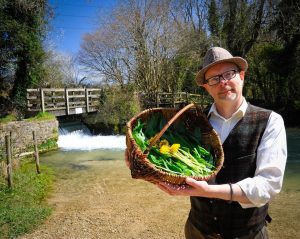Tinctures were first introduced to me in my travelling years in northern England. A fellow man of the roads named Pete had a reputation for working effectively with plant medicines and treating people who lived on the sites where we lived when they went down with coughs, colds and tummy bugs. Pete introduced me to his passion for making simple tinctures and 25 years on I make and use them all the time.
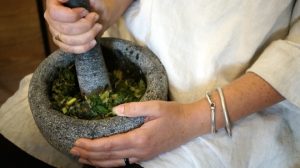
Preparing a batch of fresh herb for tincturing
Tinctures need not be a mystery, in fact in this blog I am going to tell you all about what they are, why they are useful and I’m generally going to de-mystify them for you, as one of the things that I often get asked is ‘what is a tincture’. Well… tinctures are useful things, I reply!
All living things, including plants, are absolutely jam-packed full of organic chemicals, many of which our amazing body is capable of using in different ways; there are essential nutrients, vitamins, minerals, enzymes that catalyse chemical reactions in our bodies, materials that provide food for the healthy bacteria and fungi that live inside us, compounds that block certain chemical reactions and provide relief from processes such as inflammation, substances that tone up mucous membranes and toughen up tissue, the list goes on and on and on and is in fact huge! Aside from the minerals, all of these compounds are known as ‘organic compounds’ because they contain the basic carbon building blocks of organic life – so the term ‘organic compounds’ has nothing to do with organic agriculture, or the notion that ‘organic things are good’. In this case, organic simply refers to the chemistry of carbon and molecules with a carbon backbone (think ‘carbon based life-forms’).
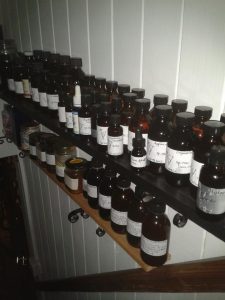
Tinctures – potent herbal medicines in a compact form
A herbal tincture is a preparation where some of the organic compounds in herbs are ‘extracted’ in a solvent which is usually alcohol in the form of ethanol (brandy, vodka, etc.) but it can also be glycerol (called a ‘glycerite’), or even vinegar, which is a source of the organic solvent ethanoic acid or ‘acetic acid’. What matters here is that we are using various organic solvents to dissolve the organic compounds present and get them into a solution. Depending on the solvent used, as well as its strength or concentration and how much water is also present, different strengths of tinctures with different ranges of medicinal actions can be obtained. Some of the compounds present in plants do not dissolve very well at all in alcohol, so for example if you were keen to create a medicine that used the soothing mucilaginous ingredients found in mallows there would be little point in making a tincture of your mallow roots or leaves in spirit – the soothing slippery substance known as mucilage has a low solubility in ethanol. Once in a solution the dissolved compounds in a tincture become very available to the various chemical processes that happen when we ingest them.
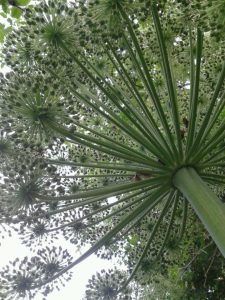
Angelica, Angelica archangelica
used as an anti-microbial / anti-viral, keep the acrid sap off of the skin when preparing
There is less in the way of organic compounds in a few drops of plant tincture than there was in the amount of herb that was used to make it, yet some tinctures behave in ways when we take them that point to their active principles being very readily available to the body. Some tinctures can be quite powerful in their actions; very often with tinctures a little plant goes a long way!
To traditional folk herbalists a tincture is also much more than a chemical based medicine. In European folk belief, it is as if the very souls of the plants come to reside in the tinctures. Tinctures are seen as potions brimming with life forces and even consciousness rather than as the dead chemical medicines that we have come to expect, but that is a whole different story.
There are many methods that can be employed to make tinctures and each of them has its merits and its complications. Tinctures can be made by the slow passage of solvent through a large batch of herb material in the filtration method, and probably the most common method, the ‘weight to volume method’, requires that a given volume of solvent be used to extract the vital ingredients from a given weight of dried herbal material, providing a certain amount of standardisation as regards the process.
However it should be remembered that plants are not standard things. Depending on the weather patterns that year, the strains used, the soil type they are grown in, how many viral and insect attacks they have had to endure already and probably a whole load of other things we aren’t even aware of, plants are not easily standardised.
The most simple tincturing methods use chopped up fresh plant material rather than dried and here I am going to give you the most basic method, often known as ‘The Simplers’ Method’. It is more than adequate for most home use in that it provides very effective tinctures at a low cost and for the minimum amount of effort. Really it is perfect for the kitchen herbalist making remedies at home.
The Simplers’ Method
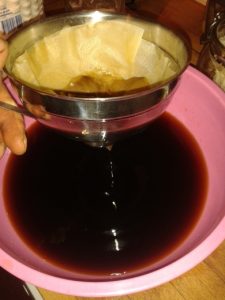
Beautiful, delicately perfumed rose-flower tincture
used by the most famous of European plague doctors, Nostrodamus
Firstly, by way of explanation, historically a ‘simpler’ was a person who created medicines from plants, and perhaps minerals too, employing a very small number of plants (often just one) in each medicine. This approach is great for making mild remedies that deal effectively with the symptoms of common ailments and is a thread of tradition within folk herbalism. In contrast, modern holistic practitioners look deeply into the whole life patterns of their patients and prescribe complex regimens of herbs to address deep seated patterns and imbalances.
At their simplest, most basic level, the ‘herbal simples’ include the tinctures made by the simplers’ method and a range of other ‘simple’ pills and potions that are perhaps most effectively used in a similar way to over-the-counter medicines. A fundamental difference that cannot be over-emphasised is that even a single plant may contain hundreds of organic compounds in a state of dynamic electrochemical balance. By contrast most over the counter pharmaceuticals contain one single isolated active ingredient – so in other words there is nothing simple at all about a simple!
Making a Specific Tincture
A simple tincture that uses fresh (non-dried) plant material in a ratio of 1 part by volume of herb to 1 part by volume of solvent (typically brandy) is known as a ‘specific tincture’. I use the abbreviation ‘sp. tinc.’ on my labels to denote this. In practice this produces a tincture that is weaker than 1 part herb to 1 part solvent due to the air spaces in between the chopped plants and the water content of the plants, but for our purposes these tinctures are generally plenty strong enough for use.
Plants that are useful for tincturing using this method include those with a lot of essential oils and other volatile (typically ‘smelly’) compounds as well as a range of other ethanol soluble compounds such as alkaloids and organic acids. It is also suitable for herbs with some water soluble components as brandy or vodka for sale in the UK typically contains 40% alcohol by volume, the remaining 60% being comprised of water.
In the days when alchemical methods dominated the preparation of herbal medicines, the ‘spirit of vine’ (brandy) was highly regarded. Because all fermented plant material eventually produces alcohol, which when fully distilled yields ethanol regardless of which plant you started with, ethanol or ‘pure spirit’ was regarded as the spirit held in common by all plants, in contrast to their soul or essence which bore the characteristics of the individual species and even the individual plant concerned. Using this alchemical terminology the process of tincturing is one of dissolving the soul of the plant concerned in a sea of plant spirit – known as the menstruum. Just as the metal mercury was regarded as the spiritual principle of all metals by the alchemist, so spirit of wine was regarded as the equivalent – a vital source of the spirit of all living plants, also metaphorically described in some mediaeval texts as ‘mercury’.
I digress… for those of you who have followed thus far, here is my version of the simplers’ method, laid bare for you I hope in terms that are simple to understand.
Recipe – Ingredients and some equipment that you need:
- Herb material containing alcohol and water soluble compounds suitable for tincturing. In practice many but certainly not all herbs.
- Spirit in the form of brandy, vodka or stronger spirit (‘spyritus’ / ‘everclear’) so long as it is fit for human consumption. Do NOT use rubbing alcohol / isopropyl alcohol as this is poisonous. The spirit should contain at least 40% ethanol by volume (abv) or be at least 80 proof. Stronger alcohol will extract more components but less of the water soluble components producing different characteristics.
- A clean, sterilised bottle and lid
- A funnel
- A clean, thoroughly rinsed tea-towel or muslin cloth
- An unbleached coffee filter or similar
- Labels
Step 1) Take a herb that contains useful ethanol soluble and / or water soluble components. Typical herbs that fit the bill are rose flowers, lemon balm, angelica, skullcap, meadowsweet, etc. Avoid herbs that have very strong actions and carry a risk of toxicity like some of the nightshades for example. This method does not give a very clinically accurate dose and you wouldn’t want to run the risk of taking too much of these stronger herbs. According to folk tradition the herb should not be cut down with an iron blade and should not be allowed to touch the ground unless it is a root – make of that what you will – I’ll leave it up to the reader to decide if it has any importance themselves. It is most definitely important however that you use plant material cut at the time of the year when that plant is at its most potent (research) and that the material that you use is not diseased or damaged in any way by pollution.
Step 2) Chop, shred, bruise and dismember the herb using whatever means are available. Stone pestles and mortars can be useful as can rolling pins and perhaps a blender! The purpose of this is to rupture cell walls as well as dramatically increasing the surface area that will be exposed to the solvent. BEWARE though – once cell walls are ruptured, enzymes will be set loose that may catalyse the rapid degradation of your plant material. You will need to work quickly to get this stage complete and to get the plant material (known as the ‘marc’) into the solvent (stage 3) to counteract this as much as possible.
Step 3) Place the chopped, bruised herb material into a washed and sterilised jar so that when pressed down it three-quarter fills the jar. Pour in your spirit a little at a time, whilst stirring the herb about with a small stick or the handle of a wooden spoon, to release any trapped air. This will ensure maximum contact between the spirit and the herb, preventing any of the material from spoiling as ethanol is a very good preservative. Once you cannot fit any more spirit in, ‘podge’ (technical term) the herbs down with your stick / spoon handle so that they fit into the jar in a nice compact way and then top up the fluid so that it covers the herbs by around one centimetre. A little less is ok, this is not a precise science. The objective is to prevent the herbs in the jar from sticking out of the spirit for long periods of time as this could cause them to oxidise and spoil. Place on the lid and tighten.
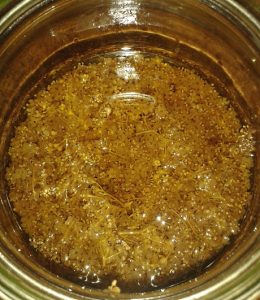
Elderflowers tincturing in vodka
Step 4) Place the jar somewhere where you will see it a lot. You will need to shake the jar once daily and podge the herbs back down below the spirit each time. If you put the jar on the shelf that is directly in front of you when you eat your breakfast you will remember to do this most days! You will need to allow the tincture to sit, shaking and podging once daily, for one month or roughly one lunar cycle. Leathery or waxy leaved herbs don’t give up their vital compounds so easily and you may need to leave them for longer, perhaps 6 weeks. The same applies to the tougher mushrooms such as the bracket fungi. The tincturing phase works best if you put the jar somewhere at ambient room temperature and with diffuse light. The UV light in daylight will encourage many compounds to dissolve by supplying a little extra energy to the mixture. Too much heat may cause some of the delicate aromatic compounds to be lost or to degrade, so when tincturing, extra heat is not recommended. Equally a cold room may slow down the process too far.
Step 5) After the allotted time has elapsed you will need to ‘press out’ and coarse filter your tincture, prior to bottling. The initial pressing out step involves passing the tincture – marc and menstruum together – into a coarse filter such as a very well rinsed clean tea-towel. The tea towel or similar is used to line a funnel and the tincture material poured slowly through it into a bowl. Once it has finished dripping, the solids can be wrapped in the tea-towel and the whole squeezed and wrung out to remove the rest of the remaining liquid. It will be cloudy and contains lots of small particles so will require further filtering if it is to be stored for long periods.
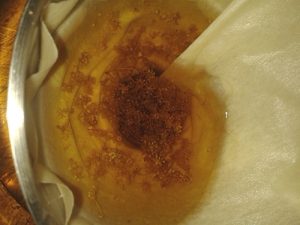
Filtering off the marc – the solids left in the filter paper
Step 6) The cloudy tincture can now be passed through a second filter to remove the fine particulates. An unbleached coffee filter works very well for this, as does a kitchen towel at a push. For maximum shelf life the resulting tincture should be completely clear.
Step 7) Tinctures, once made and filtered, should be stored in tightly stoppered bottles in a cool and dark place. Stored carefully in this way they should remain effective for at least 2 years, perhaps longer, with one or two exceptions.
How to Use a Tincture
Tinctures of the gentler herbs that are commonly used for many complaints can be taken several times per day in doses of between 5 and 30 drops per dose depending on the strength of the tincture and what it is being used to treat. The tincture should always be taken in a little water so as to reduce the alcohol by volume to below 20%. Anything above this tends to be evacuated from the stomach very quickly, hence the need for dilution. Some tinctures, for example tincture of Arnica montana, are traditionally used on the skin rather than internally. If you are doing this it would be a good idea to do a little spot test somewhere first to make sure that you are not allergic to the herb being used. Always do thorough research about the plants that you are working with.
Disclaimer: Everything in this article is provided for your entertainment only. I do not endorse you, the reader, to carry out these practices and if you do then you are doing so at your own risk. I am not responsible for the consequences if you decide to follow the information on this page. Always consume alcohol sensibly and if you take herbs check for any contra-indications that may be damaging to health or interact with other medications first.
I hope you have enjoyed reading this article! If you would like to gain some practical experience of working with herbs and of tincturing, you could try one of our herbal weekend courses here, where we will show you everything you need to know to get you started:

